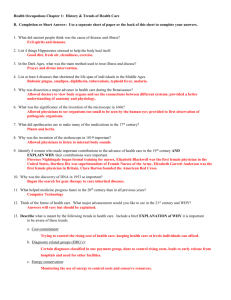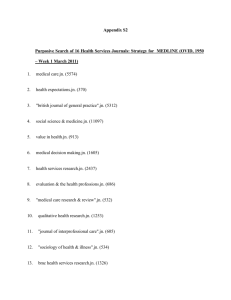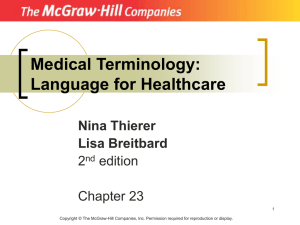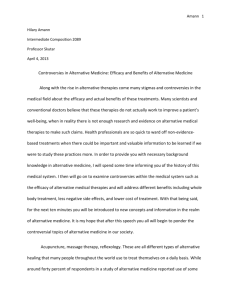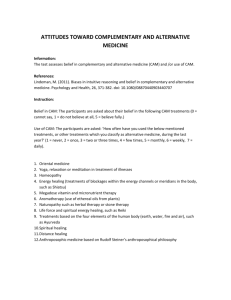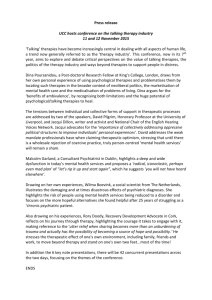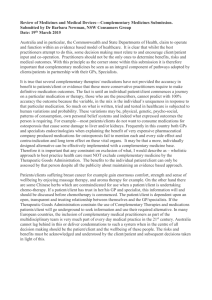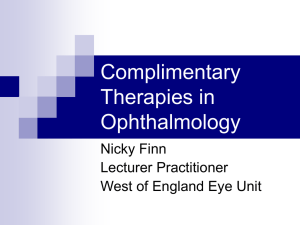Learning Objectives
advertisement
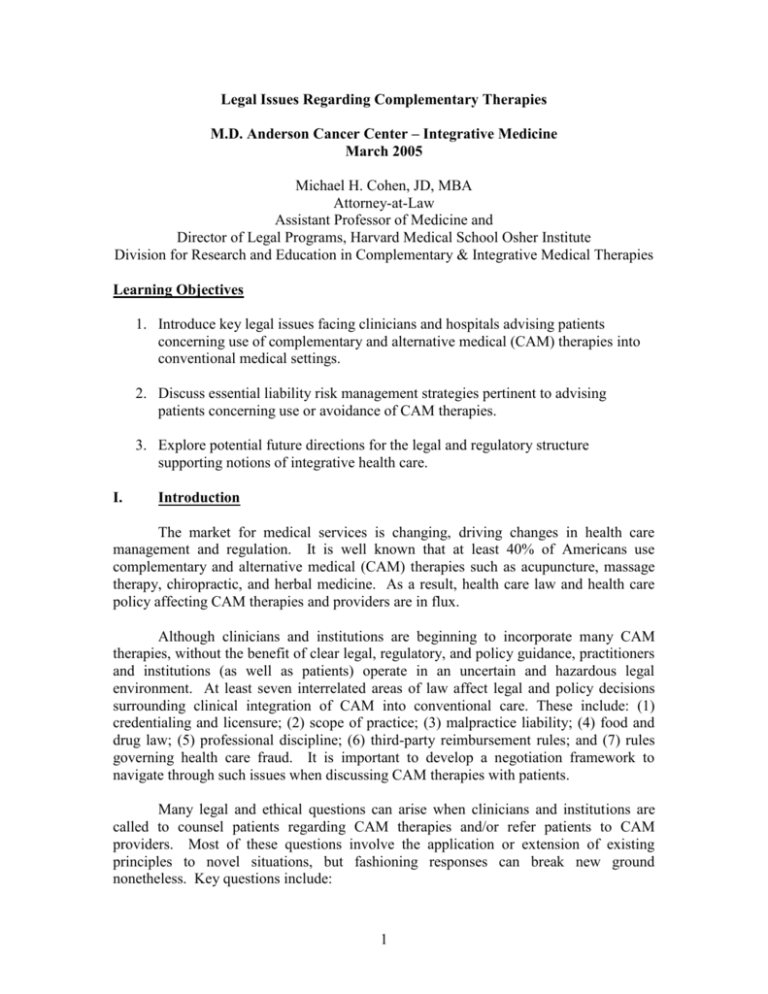
Legal Issues Regarding Complementary Therapies M.D. Anderson Cancer Center – Integrative Medicine March 2005 Michael H. Cohen, JD, MBA Attorney-at-Law Assistant Professor of Medicine and Director of Legal Programs, Harvard Medical School Osher Institute Division for Research and Education in Complementary & Integrative Medical Therapies Learning Objectives 1. Introduce key legal issues facing clinicians and hospitals advising patients concerning use of complementary and alternative medical (CAM) therapies into conventional medical settings. 2. Discuss essential liability risk management strategies pertinent to advising patients concerning use or avoidance of CAM therapies. 3. Explore potential future directions for the legal and regulatory structure supporting notions of integrative health care. I. Introduction The market for medical services is changing, driving changes in health care management and regulation. It is well known that at least 40% of Americans use complementary and alternative medical (CAM) therapies such as acupuncture, massage therapy, chiropractic, and herbal medicine. As a result, health care law and health care policy affecting CAM therapies and providers are in flux. Although clinicians and institutions are beginning to incorporate many CAM therapies, without the benefit of clear legal, regulatory, and policy guidance, practitioners and institutions (as well as patients) operate in an uncertain and hazardous legal environment. At least seven interrelated areas of law affect legal and policy decisions surrounding clinical integration of CAM into conventional care. These include: (1) credentialing and licensure; (2) scope of practice; (3) malpractice liability; (4) food and drug law; (5) professional discipline; (6) third-party reimbursement rules; and (7) rules governing health care fraud. It is important to develop a negotiation framework to navigate through such issues when discussing CAM therapies with patients. Many legal and ethical questions can arise when clinicians and institutions are called to counsel patients regarding CAM therapies and/or refer patients to CAM providers. Most of these questions involve the application or extension of existing principles to novel situations, but fashioning responses can break new ground nonetheless. Key questions include: 1 1. Who will likely get sued? 2. What kinds of protective measures will allow responsible, clinical integration of CAM therapies while minimizing risks of civil liability, criminal prosecution, or professional discipline? 3. What is the liability for referral of the patient to a CAM provider? 4. To what extent are liabilities by various providers shared in integrative medicine centers? 5. How important is it for various individuals and institutions it to understand credentialing systems applicable to CAM providers? To what extent may non-licensed providers (such as herbalists and homeopaths in some cases) be included in insurance and referral networks? 6. What are the relevant elements of an appropriate, informed consent disclosure, and when is lack of disclosure likely to trigger potential liability? 7. What are the most important risk management strategies for the clinician? How can these be implemented within the institution? Legal questions cannot be answered in a black-and-white fashion; more typically, lawyers can offer a spectrum of risk within which clinicians and other principals can develop options. Having said that, there is a crucial need to provide leadership in legal and regulatory developments to answer these questions in ways that can serve hospitals, academic medical centers, educational institutions, patients and their families, and federal, state, and local governments who are creating law and setting policy. Many of these questions—and the conundrums they present—will be addressed in the talk, with further detail provided in some of the resources listed in IV. below. II. About Legal Programs Many people are curious as to how a lawyer becomes a medical academic doing policy research concerning integrative medicine. I began this exploration around 1992 in the attempt to merge my professional identity as a lawyer with a growing personal interest in spirituality and different forms of healing. This burgeoned into scholarly exploration of new topics in health law, as the field of “alternative medicine” began to gain recognition. The work continued in legal academe, ultimately resulting in publications and an offer from Harvard Medical School to participate in its new Division for Research and Education in Complementary and Integrative Medical Therapies. Within the Division, Legal Programs has supported the mission of the Division, and the broader field of integrative medicine, by contributing legal, ethical, and 2 regulatory expertise to research and education, and to its development of institutional policies that ultimately can be implemented across Harvard Medical School-affiliated hospitals. One major goal thus far has been to articulate reproducible guidelines to help health care institutions understand how to credential CAM providers and conventional providers to offer CAM therapies within an evidence-based medical center, and to help such institutions manage potential malpractice liability in the process. To date, we have received funding from the National Institutes of Health (NIH), the Toronto Hospital for Sick Children, the Rudolph Steiner Foundation, the Greenwall Foundation, and other sources in a variety of grants. Our participation in NIH-funded projects to date has included: 1. Models of Integrative Care in an Academic Health Center: This research project, funded by the National Center for Complementary and Alternative Medicine (NCCAM) at the National Institutes of Health and Medtronic Foundation, involves helping to develop the integrative clinical care center, particularly with regard to guidelines for credentialing providers, managing liability risk, and establishing guidelines concerning vitamins, herbs, and other dietary supplements. 2. Legal and Social Barriers to Alternative Therapies: This research, funded by the National Library of Medicine at the National Institutes of Health, uses qualitative and ethnographic research to prepare a scholarly, book-length manuscript that critically evaluates the integration of CAM therapies into conventional medical settings in the United States. Our co-investigator is Mary Ruggie, Ph.D. at the Kennedy School of Government. 3. International Center for CAM Research (Co-Investigator, 2002-2004): This is an NCCAM-funded planning grant focusing on the systematic evaluation of East Asian herbal products. The grant includes development of the necessary administrative and legal infrastructure, including negotiation of a formal collaboration agreement to satisfactorily address issues of intellectual property, royalty sharing, publication procedures, and shared access to NIH resources. We also have offered a variety of educational programs, including lectures in our Harvard Medical School elective course on CAM therapies, and in our continuing medical education and Web-based courses on legal and regulatory issues for clinicians concerned with counseling patients regarding CAM therapies. In addition, an elective course, Complementary and Alternative Medicine: Health Law and Policy (HPM218) was offered through the Harvard School of Public Health in the Winter Session, 2003 and 2004 (see III). 3 III. Course Description for Harvard School of Public Health Complementary and Alternative Medicine: Health Law and Policy M. Cohen Course activities: Lectures, discussions, case studies. Weekly 2-hour session. This course introduces students to health law and policy surrounding the integration of “complementary and alternative medical” (CAM) therapies (i.e., therapies historically outside biomedicine, such as chiropractic, acupuncture, massage therapy, and herbal medicine) into mainstream health care. Topics include: definition and prevalence of CAM therapies; theory and practice of major CAM therapies; research methodologies and state of the science; licensing and regulation of CAM providers; professional discipline of physicians offering CAM therapies; credentialing and liability management strategies by health care institutions integrating these therapies; malpractice liability and informed consent issues; federal regulation of (and institutional policy involving) dietary supplements; emerging federal policy and state legislative developments; and related ethical questions. Readings are drawn from medical, public health, and health policy literature, as well as from statutes and cases. Students are expected to write an 8 to 10 page final paper and present a synopsis in class. No previous background in law is required, although HPM 213c and 215d are recommended. IV. Selected Resources Articles Adams KE, Cohen MH, Jonsen AR, Eisenberg DM. Ethical considerations of complementary and alternative medical therapies in conventional medical settings. Ann Intern Med; 2002;137:660-664. Astin JA. Why patients use alternative medicine: results of a national study. JAMA 1998; 279:1548-53. Cohen MH. Legal and ethical issues in complementary medicine: a U.S. perspective. Med J Australia 2004;181:3:168-169. Cohen MH. Negotiating integrative medicine: a framework for provider-patient conversations. Negotiation J 2004;30:3;409-433. Cohen MH, Eisenberg DM. Potential physician malpractice liability associated with complementary/integrative medical therapies. Ann Intern Med; 2002;136:596-603. Cohen MH, Ruggie M. Integrating complementary and alternative medical therapies in conventional medical settings: legal quandaries and potential policy models. Cinn L Rev 2004; 72:2:671-729. 4 Cohen M, Schacter S. Facilitating IRB consideration of protocols involving complementary and alternative medical therapies. Clin Researcher 2004;4:3:2-6. Dietary Supplements Health Education Act, 103 P.L. 417; 108 Stat. 4325; 1994. Executive Summary, Final Report, White House Commission on Complementary and Alternative Medicine Policy (2002). Ernst EE, Cohen MH. Informed consent in complementary and alternative medicine. Arch Intern Med 2001;161:19:2288-2292. Eisenberg DM, Cohen MH, Hrbek A, Grayzel J, van Rompay MI, Cooper, RA. Credentialing complementary and alternative medical providers. Ann Intern Med; 2002;136;660-664. Eisenberg DM. Advising patients who seek alternative medical therapies. Ann Intern Med. 1997;127:61-69. Federation of State Medical Boards, Guidelines for Complementary and Alternative Therapies in Medical Practice (2002) (available at www.fsmb.org). Federal Trade Commission. Dietary Supplements: An Advertising Guide for Industry (available on-line at www.ftc.gov) Food and Drug Administration. Regulations on Statements Made for Dietary Supplements Concerning the Effect of the Product on the Structure or Function of the Body, 21 CFR Part 101, 65:4 Fed Reg 1000 (Jan. 6, 2000). Hathcock J. Dietary supplements: how they are used and regulated. Journal of Nutrition. 131(3s):1114S-7S, 2001 Mar. Kaptchuk TJ. Varieties of Healing 1: Medical Pluralism in the United States. 135 Ann. Int. Med. 189 (2001). Kaptchuk TJ. Varieties of Healing 2: A Taxonomy of Unconventional Healing Practices, 135 Ann. Int. Med. 196(2001). Kolton EA. Physician Sale of Dietary Supplements (Washington, D.C.: Emord & Associates). Marcus DM & Grollman AP, Botanical Medicines—The Need for New Regulations. 347:25 N.Engl.J.Med. 2073 (2002). McNamara SH. Regulation of dietary supplements. New England Journal of Medicine. 343(17):1270, 2000 Oct 26. 5 Pelletier KR, Astin JA, Haskell WL. Current trends in the integration and reimbursement of complementary and alternative medicine by managed care organizations (MCOs) and insurance providers: 1998 update and cohort analysis. Am J Health Promot 1999; 14(2):125-33. Pelletier KR, Marie A, Krasner M, Haskell WL. Current trends in the integration and reimbursement of complementary and alternative medicine by managed care, insurance carriers, and hospital providers. Am J Health Promot 1997; 12:112-123. Studdert DM, Eisenberg DM, Miller FH, Curto DA, Kaptchuk TJ, Brennan TA, Medical malpractice implications of alternative medicine [see comments], 280 JAMA 1610 (1998). Young AL. Bass IS. The Dietary Supplement Health and Education Act. Food & Drug Law Journal. 50(2):285-92, 1995. Books Callahan D, ed. The role of complementary & alternative Medicine: accommodating pluralism. Washington, D.C.: Georgetown University Press, 2002. Cohen MH. Complementary and alternative medicine: legal boundaries and regulatory perspectives. Baltimore: Johns Hopkins University Press; 1998; 180 pages. Cohen MH. Beyond complementary medicine: legal and ethical perspectives on health care and human evolution. Ann Arbor: University of Michigan Press; 2000; 214 pages. Cohen MH. Future medicine: ethical dilemmas, regulatory challenges, and therapeutic pathways to health and human healing in human transformation. Ann Arbor: University of Michigan Press; 2003; 359 pages. Legal issues in integrative medicine. Washington, D.C.: National Acupuncture Foundation (in press, 2005); 100 pages. Ernst EE, Pittler MH, Stevinson C, & White A. The desktop guide to complementary and alternative medicine: an evidence-based approach. London: Harcourt Publishers Ltd., 2001; 444 pages. Faas, N, ed. Integrating complementary medicine into health systems. Gaithersburg, Maryland: Aspen Publishers, Inc., 2001; 763 pages. Humber JM & Almeder RF, eds.. Alternative medicine and ethics. Atlanta: Humana Press, 1998; 220 pages. Slater V & Rankin-Box D. The nurses’ handbook of complementary therapies. New York: Churchill-Livingstone, 1996. 6 Websites Websites specifically pertaining to regulation of dietary supplements American Dietetic Association http://www.eatright.org/gov/supplements.html Berkeley Wellness Letter http://www.berkeleywellness.com/html/ds/dsSupplements.html FDA http://vm.cfsan.fda.gov/~dms/supplmnt.html Labels http://www.fda.gov/bbs/topics/NEWS/NEW00678.html FTC http://www.ftc.gov/bcp/conline/pubs/buspubs/dietsupp.htm NIH http://dietary-supplements.info.nih.gov/ Database http://ods.od.nih.gov/databases/ibids.html Facts http://www.cc.nih.gov/ccc/supplements/intro.html NIH Press Release http://www.nih.gov/news/pr/oct99/ods-06.htm NLM http://www.nlm.nih.gov/services/dietsup.html Dietary Supplement Info Bureau www.supplementinfo.org USDA http://www.nalusda.gov/fnic/etext/000015.html Books http://www.nalusda.gov/fnic/pubs/bibs/gen/dietsupp.html USP http://www.usp.org/frameset.htm?http://www.usp.org/dietary/ Other websites White House Commission on Complementary and Alternative Medicine Policy http://www.whccamp.hhs.gov/ Legal Resources – Michael H. Cohen www.michaelhcohen.com 7 Institute of Medicine, Committee on Use of Complementary and Alternative Medicine by the American Public www.iom.edu/cam V. Contact Information Michael H. Cohen, JD Director of Legal Programs Harvard Medical School Osher Institute 401 Park Drive, 22-W Boston, MA 02215 (617) 384-6398 or visit: Complementary and Alternative Medicine Law Blog www.camlawblog.com 8
